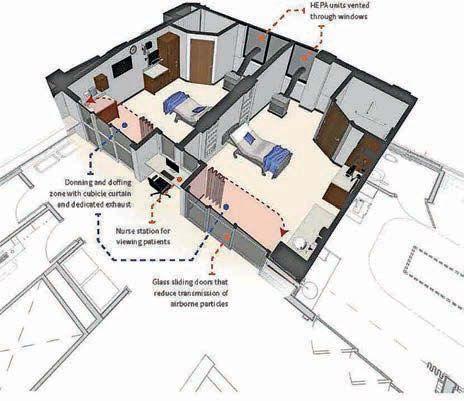
3 minute read
AEC firms take project design to the virtual skies with desktop infrastructure
By Brian C. Smith
system/network provides whatever processing power and memory is needed for users, scaling up and down dynamically.
How is that even possible? As demand grows, additional hardware resources are engaged to meet the demand. As the user base and software needs grow, the hardware is added or upgraded.
Each user has a local profile on this host system and functions as if they were entirely on their computer, yet they access it from any computer remotely – anytime, anywhere.
Why use VDI?
Brian C. Smith

The way architects and engineers work has changed dramatically in recent years. Driven by an influx of remote and virtual workers in disparate locations, new and innovative graphics-rich applications that AEC professionals require for their projects, and the need for more agile and cost-effective technology solutions, AEC firms continue to forge ahead. In doing so, they are transforming their operations to accommodate how design and build professionals now work, in light of the pandemic, and to continue to be competitive in an already rivalrous environment.
One major part of this transformation that successfully harnesses the new norm of remote and virtual work, project collaboration, and reduced IT costs in one fell swoop is Virtual Desktop Infrastructure (VDI).
What is VDI?
VDI is the concept of taking a localized computer system or resources and placing them on a centralized server. This server can be local to a company or cloud-based and hosted around the country or world. You will often hear Virtual Desktop in association with the company that provides it. For example, Windows® Virtual Desktop, or WVD.
Today’s Virtual Desktops have multiple users accessing a shared pool of resources from a host system or network of host systems. Host systems are made up of servers that are interconnected computers dedicated and optimized to perform specific tasks. The host
Virtual Desktops simplify the management of IT infrastructure and alleviate challenges, allow for real-time collaboration providing users access to graphic-intensive applications such as Autodesk® Revit®, Autodesk® Civil 3D®, Lumion®, and Enscape®, and empower employees with work-life balance making it easier for them to work when it’s convenient from anywhere an Internet connection is available.
Ever experience issues with bandwidth or connectivity when working remotely or over a VPN? With Virtual Desktops, work happens on the remote host system, bypassing these bottlenecks. There is no need for files to be transferred over the user’s personal network connection. The files, software, and resources are in the same bubble, with optimized connections to each other.
With office-based IT hardware and equipment costs on the rise, Virtual Desktops are a great alternative as users do not need highend computers.
Thin clients (affordable computers) connect with a Virtual Desktop. They are scalable, so you only pay for what you need when you need it. Baseline costs and usage stay predictable through a monthly subscription cost instead of an upfront capital expense. And keeping everyone updated on the correct version and troubleshooting issues is a breeze with VDI.
IT teams have centralized control over deployment, management, and updates with a lower failure rate. The end-user experience is customizable, but access control is centralized. If something goes wrong, a new profile or host can be deployed to keep the user working, ensuring productivity on projects and less downtime.
With VDI, employees are empowered to complete their projects with the graphics-rich applications they need while collaborating with stakeholders with ease – inside or outside the firm. When it’s time to hire new talent, it no longer matters where the employee resides as a Virtual Desktop can be provisioned quickly, broadening a firm’s recruiting reach to attract top talent from anywhere.

What to consider on the technical side about VDI Networking. A broadband internet connection is recommended for the best experience. 15/15 Mbps and under 150ms of latency to the Azure region resources are hosted in. Licenses. For Windows Virtual Desktop, every user will require a Windows 10 Enterprise account. Windows Virtual Desktop runs on Windows 10 Enterprise with Windows Server elements that allow multiple concurrent interactive sessions. Every user has their own Windows Profile. Autodesk applications require Single-User Sign-On.
Usage. The number of users and the uptime in the firm is needed. Uptime being the time users need access to the systems. Starting with more than enough resources to meet demands are essential for success, adoption, and getting baseline costs quickly and accurately. Windows Virtual Desktop runs on Azure® (a cloud service provider), making it seamless to transition to a virtual workspace instead of solely relying on in-house/on-premises infrastructure. Local outages are decreased, and an off-site provider manages backups and redundancies – freeing up IT resources’ time to focus on higher priority work. Employees enjoy greater work-life balance, uninterrupted productivity, and project collaboration and delivery are unimpeded. An AEC technology partner, such as U.S. CAD, can provide a turnkey VDI solution with implementation services including setup, configuration, deployment, scaling, application installation, and providing best practices to users.
Brian C. Smith is a cloud solutions specialist at U.S. CAD based in Irvine, Calif. The company has offices located in Minnesota, Missouri, and 11 additional major metropolitan cities.
“AtMDU Resources, ourtag line is Building aS tr on gA me ri ca .T he ND SU C olleg eof Engineeringpreparesgraduatestodojust that –tolead, innovateand do theirpar t to builda strongAmerica .” Davi
SPONSORED BY










